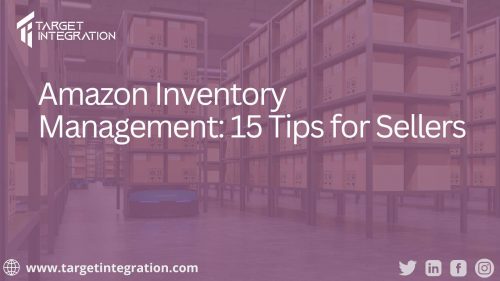Amazon, with its well-established ecosystem, offers fantastic opportunities for entrepreneurs looking to kick-start their journey on the platform. However, amidst these vast opportunities, newcomers often face a range of challenges. One of these hurdles is the complicated process of effective inventory management, a critical factor that can significantly impact your business’s success and ability to generate healthy profits.
In this article, we’ll delve into the importance of effective inventory management and provide you with essential tips to navigate this aspect of your business successfully.

Why Amazon Sellers Need to Do Inventory Management
After selecting your niche, finding products to sell, and completing your purchase, your next step should be determining your method and duration of inventory storage. This is where the task of inventory management becomes a critical concern.
Amazon inventory management refers to the process of overseeing and controlling the stock of products that a seller offers on the Amazon platform. This process is critically important for several reasons:
- Avoiding Stockouts: Running out of stock can lead to missed sales opportunities, lost revenue, and damage to your seller metrics. Effective inventory management helps prevent stockouts by monitoring inventory levels and ensuring timely replenishment.
- Optimal Cash Flow: Holding excessive inventory ties up capital that could be used for other business needs, such as marketing, product development, or expanding your product line. Managing inventory efficiently helps strike a balance between having enough stock to meet demand and avoiding unnecessary financial strain.
- Reduced Storage Costs: Amazon charges fees for storing inventory in their fulfillment centers. Overstocking or keeping slow-moving items in storage for extended periods of time can result in higher storage costs. Proper inventory management minimizes these costs by optimizing your use of storage space.
- Improved Profit Margins: Managing your inventory effectively can help you make more informed pricing decisions. For instance, sellers can implement dynamic pricing strategies based on demand and competition, maximizing profit margins while remaining competitive in the marketplace.
In summary, effective Amazon inventory management is vital for maintaining a competitive edge, keeping customers satisfied, optimizing financial resources, and ensuring compliance with Amazon’s policies. It is a foundational aspect of running a successful e-commerce business on the Amazon platform.
How to Manage Inventory on Amazon Effectively
Now that we’ve covered why this process is essential, let’s delve into what sellers can do to enhance their inventory management.
1. Set clear goals and objectives
Define your inventory management goals, such as optimizing cash flow, reducing holding costs, or improving customer satisfaction. Establish key performance indicators (KPIs) to help you measure the success of your inventory management efforts, such as inventory turnover rate, stockout rate, or carrying cost percentage.
2. Categorize your inventory
Divide your inventory into categories based on factors like demand, seasonality, and product category. This helps tailor your management strategies to each category’s unique characteristics.
3. Implement inventory management software
It’s a good idea to invest in inventory management software that integrates with your e-commerce platform (e.g., Amazon Seller Central). This software can automate various aspects of inventory management, such as tracking stock levels, generating reports, and setting reorder points.
4. Forecast demand
Use historical sales data, market trends, and seasonality patterns to forecast demand for your products. Accurate demand forecasting is essential for maintaining the correct inventory levels.
5. Set reorder points
Determine reorder points for each product based on lead times, sales velocity, and desired safety stock levels. When inventory levels reach the reorder point, it’s time to reorder more stock.
6. Regularly audit and update inventory
Conduct routine physical inventory counts to verify stock levels and identify any discrepancies between physical and recorded inventory. Regular audits help maintain accuracy.
7. Optimize your supply chain
Collaborate closely with suppliers to ensure timely deliveries and reduce lead times. Explore options like just-in-time (JIT) inventory management to minimize excess stock.
8. Prioritize fast-moving products
Give priority to products with high demand and fast turnover. These items should be well-stocked to prevent stockouts and maximize revenue.
9. Identify slow-moving or obsolete inventory
Review your inventory regularly to identify which items are slow-moving or even obsolete. Implement strategies to clear out these pieces of inventory, such as discounts, bundling, or liquidation.
10. Utilize fulfillment services
On Amazon, consider using Fulfillment by Amazon (FBA) to outsource all aspects of your storage, packing, and shipping. FBA can help streamline fulfillment and improve shipping times.
11. Implement an “ABC Analysis”
Use an ABC analysis to categorize products into three groups: A (high-value, low-quantity), B (moderate-value, moderate-quantity), and C (low-value, high-quantity). Allocate more resources to managing A items.
12. Monitor market trends
Stay informed about market trends, competitive products, and changes in customer preferences. Be ready to adjust your inventory and product offerings accordingly.
13. Automate reordering
Consider using automated reorder systems that trigger purchases when inventory levels reach predefined thresholds. This reduces the risk of stockouts and overstocking.
14. Review and adjust your strategy regularly
Evaluate the effectiveness of your inventory management strategies continuously. Make adjustments as needed to align with changing market conditions and business goals.
15. Comply with platform policies
Ensure that your inventory management practices align with the policies of the e-commerce platform you’re using, such as Amazon’s inventory policies.
By following these steps and maintaining your focus on accuracy and efficiency, you can successfully manage your inventory and contribute to the overall success of your business.
Conclusion
Mastering Amazon inventory management is about more than just keeping track of products. It’s also about optimizing your entire e-commerce operation. This is an ongoing process that requires a careful approach, data analysis, and adaptation to market dynamics.
It’s also important to consider that inventory management is intricately linked with other critical business processes, including product research, supply chain management, and product promotion. Therefore, it’s essential to review and integrate all these aspects into a cohesive business operation.



